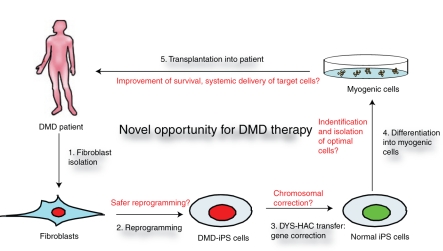Figure 1.
A novel approach to treating Duchenne muscular dystrophy (DMD) using a combination of gene and iPS cell-based therapy. The sequential completion of combinatorial DMD therapy is represented in the diagram. Fibroblasts are readily cultured from a DMD patient (1) and reprogrammed to generate iPS cells (2). Using a human artificial chromosome (HAC) expressing the whole chromosomal region of dystrophin (DYS), the genetic defect in DMD can be repaired in fibroblasts before reprogramming, or in iPS cells (3) as described by Kazuki et al.2 Myogenic cells differentiated from corrected normal iPS cells (4) can then be transplanted back into the patient to cure the DMD (5). Shown in red are challenges to this therapeutic approach to DMD. Further optimization of reprogramming and genetic correction needs to be achieved. Laborious efforts will be directed at identifying and isolating the most efficient cells for transplantation and toward defining the optimal transplantation method.

